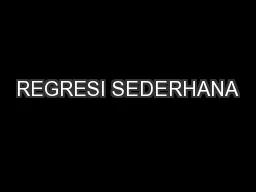

BAGIAN 2 Ekonometrika 1 Al Muizzuddin F REVIEW BAGIAN 1 Menentukan nilai koefisien bo dan b1 Asumsi dalam regresi OLS 2 A M easure of G oodness of F it THE COEFFICIENT OF ID: 565618
Download Presentation The PPT/PDF document "REGRESI SEDERHANA" is the property of its rightful owner. Permission is granted to download and print the materials on this web site for personal, non-commercial use only, and to display it on your personal computer provided you do not modify the materials and that you retain all copyright notices contained in the materials. By downloading content from our website, you accept the terms of this agreement.
Slide1
REGRESI SEDERHANABAGIAN 2
Ekonometrika
1
Al
Muizzuddin
FSlide2
REVIEW BAGIAN 1Menentukan nilai koefisien bo dan b1Asumsi dalam regresi OLS2Slide3
A Measure of“Goodness of Fit”THE COEFFICIENT OF DETERMINATION (R2)3
we shall find out how “well” the sample regression line fits the data
Figure A :
Venn diagramSlide4
In this figure the circle Y represents variation in the dependent variable Y and the circle X represents variation in the explanatory variable X.When there is no overlap, R2 is obviously zero, but when the overlap is complete, R2 is 1, since 100 percent of the variation in Y is explained by X. As we shall show shortly, R2 lies between 0 and 1.4Slide5
Analysis of VarianceThe total variability in a regression analysis, SST, can be partitioned into a component explained by the regression, SSR, and a component due to unexplained error, SSE5Slide6
With the components defined as,Total sum of squares :Error sum of squares : Regression sum of squares :6Slide7
Measure of Coefficient of Determination, R2The Coefficient of Determination for a regression equation is defined as7Slide8
Some Examples8EXAMPLE 1 : HYPOTHETICAL DATA ON WEEKLY FAMILY CONSUMPTION EXPENDITURE (Y) AND WEEKLY FAMILY INCOME (X)Slide9
9Slide10
The estimated regression line isThe value of β2 = 0.5091, which measures the slope of the line, shows that, within the sample range of X between $80 and $260 per week, as X increases, say, by $1, the estimated increase in the mean or average weekly consumption expenditure amounts to about 51 cents.10Slide11
The value of β1 = 24.4545, which is the intercept of the line, indicates the average level of weekly consumption expenditure when weekly income is zero.The value of R2 of 0.9621 means that about 96 percent of the variation in the weekly consumption expenditure is explained by income. Since R2 can at most be 1, the observed R2 suggests that the sample regression line fits the data very well.11Slide12
The data relate to a sample of 55 rural households in India. The regressand in this example is expenditure on food and the regressor is total expenditure, a proxy for income, both figures in rupees. The data in this example are thus cross-sectional data.12EXAMPLE 2 :
FOOD EXPENDITURE IN INDIASlide13
If total expenditure increases by 1 rupee, on average, expenditure on food goes up by about 44 paise (1 rupee = 100 paise).If total expenditure were zero, the average expenditure on food would be about 94 rupees.The R2 value of about 0.37 means that only 37 percent of the variation in food expenditure is explained by the total expenditure.13
FoodExp
i
= 94,20 + 0,43 TotalExp
iSlide14
The data relating average hourly earnings and education, as measured by years of schooling. Using that data, if we regress average hourly earnings (Y) on education (X), we obtain the following results.14EXAMPLE 3 : THE RELATIONSHIP BETWEEN EARNINGSAND EDUCATION
Y
i
= -0,0144 + 0,7241 X
iSlide15
As the regression results show, there is a positive association between education and earnings, an unsurprising finding. For every additional year of schooling, the average hourly earnings go up by about 72 cents an hour. The intercept term is positive but it may have no economic meaning. The R2 value suggests that about 89 percent of the variation in average hourly earnings is explained by education. For cross-sectional data, such a high R2 is rather unusual.15Slide16
Basis for Inference About the Population Regression SlopeLet 1 be a population regression slope and b1 its least squares estimate based on n pairs of sample observations. Then, if the standard regression assumptions hold and it can also be assumed that the errors i are normally distributed.16Slide17
Excel Output for Retail Sales ModelThe regression equation is Y Retail Sales = 1922 + 0.382 X Income17Slide18
Tests of the Population Regression Slope18If the regression errors
i
are normally distributed and the standard least squares assumptions hold (or if the distribution of b
1
is approximately normal), the following tests have significance value :
To test either null hypothesis
against the alternative
the decision rule isSlide19
192. To test either null hypothesis
against the alternative
the decision rule isSlide20
203. To test the null hypothesis
Against the two-sided alternative
the decision rule isSlide21
F test for Simple Regression Coefficient21We can test the hypothesis
against the alternative
By using the F statistic
The decision rule is
We can also show that the F statistic is
For any simple regression analysis.Slide22
ConclusionCoefficient intercept and slopeR-squaredF-testt-tes22Slide23
Ada pertanyaan?23Slide24
Selesai..Tugas minggu depanBaca materi regresi berganda24